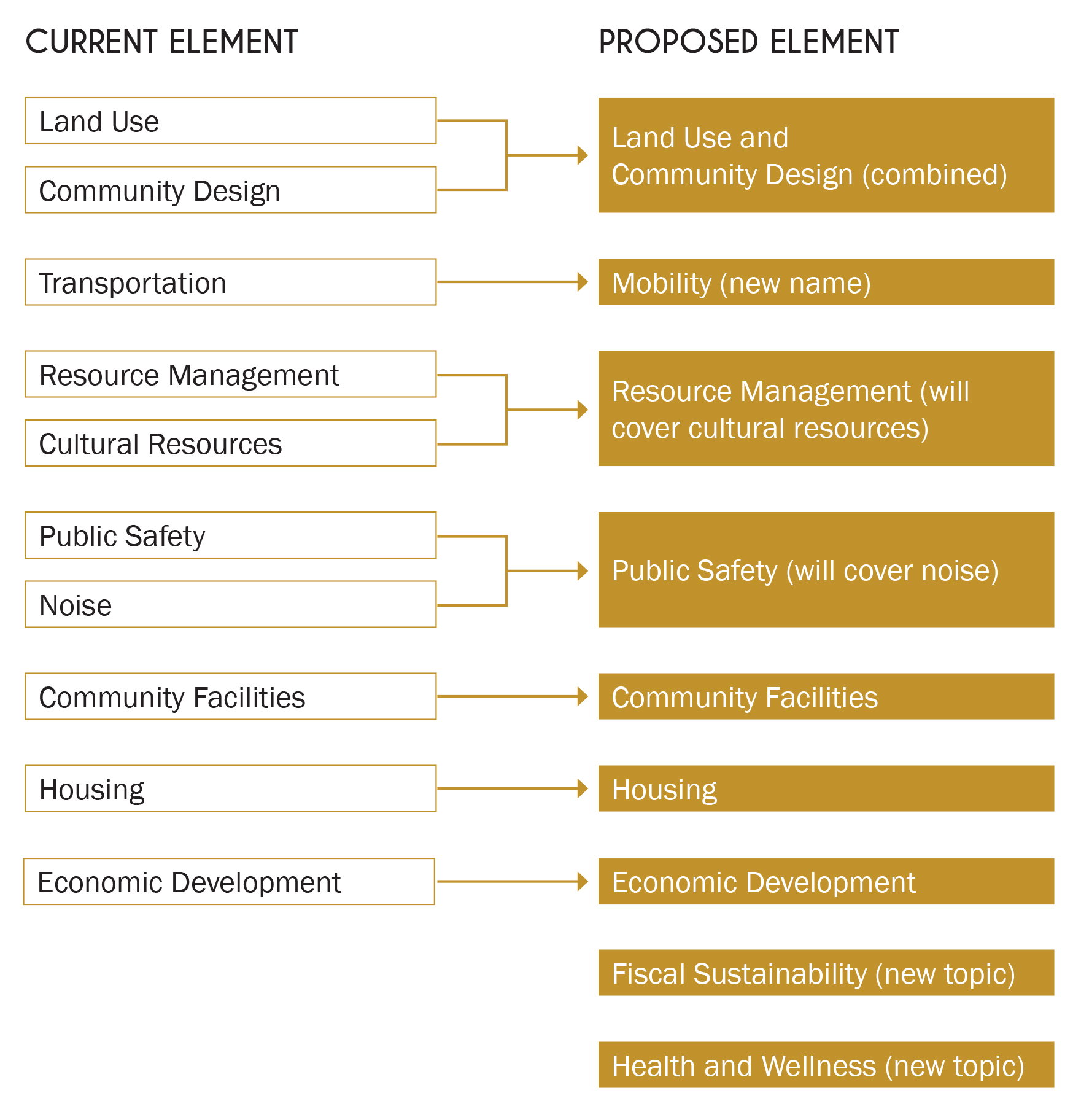FAQ
What is a General Plan?
The state of California requires every city and county in California to adopt a General Plan, which is the local government’s long-term blueprint “for the physical development of the city and any land outside its boundaries that bears relation to its planning.” The General Plan represents the community’s view of its future and expresses the long-term growth and development goals. It addresses issues that impact the entire city, such as how land is used, where buildings are built, the locations of roads and parks, safety, noise, and more
The General Plan contains the goals and policies upon which the City Council and Planning Commission will base their land use decisions. All city plans, zoning, and private development must be consistent with the diagrams and policies in the General Plan.
Why is the City updating its General Plan?
The City’s current General Plan is over 20 years old. Having just celebrated its 110th anniversary in 2016, the City of La Verne is facing important demands and challenges (some new, some long-standing) on its land use pattern, infrastructure, budget, and circulation network. Changing demographics and economic conditions, the adoption of various specific plans to guide development in focused opportunity areas, new and improved transit connections to the region, and new state legislation are some of the important reasons that the City has decided to update its General Plan.
The City's current General Plan has served La Verne well over the past 20 years, but a modern General Plan will help reflect contemporary community values and priorities and provide the framework to balance a high quality-of-life with improved economic and fiscal conditions over the next 20 years. The goals, policies, and actions of the General Plan will serve as the City’s roadmap for future decision-making and provide the community, staff, and elected and appointed officials with clear direction on where the City wants to go and what needs to happen in order to get there.
What topics are addressed in the General Plan?
General Plans are divided into elements based on specific topics. There are seven mandatory elements: land use, circulation, housing, conservation, open space, safety, and noise. State law allows local governments to organize and format their general plans however they desire, as long as the required topics or elements are addressed. Cities can also choose to include additional elements, such as community design, economic development, or historical resources.
As a part of preparing the General Plan Update, the existing elements may be reorganized and new elements may be added to emphasize new planning issues that have arisen since the current General Plan was adopted. The graphic below compares the City’s current General Plan to the proposed organization.

What is a Housing Element?
The Housing Element is a section of the City’s General Plan that addresses housing needs and conditions within La Verne. It identifies goals, policies and programs that the City uses to guide actions related to housing.
Why is the City Updating its Housing Element Now?
State law requires the Housing Element be updated every eight years (in tracked planning period cycles) and certified by the State Department of Housing and Community Development (HCD). For purposes of the Housing Element update, the State is organized into regions, with each region on a separate Housing Element cycle. The City of La Vertne is within the Southern California Association of Governments (“SCAG”) Region. The next planning period cycle, the 6th Cycle, for the SCAG Region covers 2021-2029.
The purpose of this update to the Housing Element is to ensure consistency with the City’s General Plan (which is also being updated) and compliance with state statutes for certification by HCD before October 2021. The Housing Element must be updated to include City policies, strategies, and actions to facilitate the construction of new housing and preservation of existing housing to meet the needs of the population during the 6th Cycle period. The Housing Element must also address the City’s Regional Housing Needs Assessment (“RHNA”) allocation. This requires the City to plan to accommodate the specified number of housing units for the specified income levels throughout the City. Although the City initiated its comprehensive General Plan Update in 2017, it did not previously include the update for of the Housing Element. This was because the General Plan preparation was initiated in 2018 and the RHNA had not been finalized. However, now that the RHNA is finalized, the City has added an update to the Housing Element to the work program and aligned the schedules accordingly.
What is the Regional Housing Needs Assessment (RHNA)?
The state of California is facing a housing shortage. As such, the State requires that every city and county help accommodate a portion of new housing growth. Because people often live and work in different places, housing needs are assessed at a regional level based on population trends and other factors to determine how much growth each local jurisdiction will need to accommodate. This is called the “Regional Housing Needs Assessment”—or RHNA for short. The RHNA quantifies the need for housing on a regional level, and then allocates a portion of new growth to each City.
La Verne’s RHNA allocation for the 2021-2029 planning period is 1,343. This means that La Verne is responsible for identifying areas of the City that can accommodate 1,343 new units. La Verne’s RHNA allocation is further divided into household income categories, as described on the Virtual Workshop. The City of La Verne is NOT responsible for building new homes. However, La Verne must show that there is enough land zoned for housing to accommodate our allocated share (our RHNA) of new homes. Furthermore, a special focus is placed on planning for affordable housing. The Housing Element will identify those specific locations where the City's RHNA can be accommodated, along with goals, policies, and actions to further the City's housing priorities.
What is the schedule for the General Plan?
The La Verne General Plan Update will take place over a three-and-a-half-year period from July 2017 to approximately Fall 2021.
How can I get involved?
The General Plan Update process provides an opportunity for community members to discuss and weigh in on the City’s future. We encourage you to take advantage of the many opportunities to participate, including meetings, workshops, and public hearings.
In order to collect community input in an open, engaging, and actionable way, the City has designed a series of community venues and events where you will have the opportunity to participate in and be informed of the planning process. These include:
Visioning Workshops – Three Visioning Workshops will be held to introduce the community to the project and to provide opportunities for the community to identify their vision, goals and priorities, and land use preferences for the General Plan Update.
General Plan Advisory Group (GPAC) - The GPAC will be selected by the City Council to represent the community and work directly with the General Plan Update staff and consultant team to identify issues and concerns, review land uses, and prepare the draft goals, policies, and actions that will be the foundation for each element of the General Plan. GPAC meetings will be working meetings. The public is invited to attend, but the public will not participate in the GPAC discussion.
Stakeholder Interviews – Interviews of groups and organizations that represent various local and regional issues that affect La Verne will be conducted to ensure that a broad range of perspectives are included early in the General Plan update process. Feedback collected during this stage will be subject to additional input from the broader community.
Open House – This community workshop will present the key issues that the General Plan Update addresses, the City’s primary goals and policies related to each General Plan element, and the draft land use map.
Public Review Draft General Plan – The Public Review Draft General Plan and Environmental Impact Report will be made available to the public for review and feedback before the plan is finalized. will be presented to the entire community in order to receive feedback and input.
Planning Commission and City Council Hearings –The City will conduct public hearings before the Planning Commission and City Council to consider the update to the General Plan. Community members are encouraged to attend these meetings.
Why should I get involved?
The City of La Verne is committed to involving the community in the planning process. The General Plan Update process provides residents, businesses, and interested parties the chance to help guide the future of the community. A successful General Plan will reflect the community’s vision and priorities, and we believe that your voice is vital to producing a plan that will reflect your vision for the city’s future. Community input is needed to establish the long-term vision for La Verne and to identify key issues and priorities.
How will my feedback be used?
Public input from every engagement opportunity is meticulously reviewed and documented to ensure the General Plan Advisory Committee, planners, City staff, and decision-makers have a full understanding of public sentiment when drafting goals and policies. Public feedback on General Plan materials (including goals and policies) will be considered throughout the process.
How can I stay informed?
Visit the Get Involved page to view the dates of upcoming meetings and community events. If you wish to be added to the City’s mailing list to receive project updates and invitations to community events, use the contact form and request to be added to the mailing list.
The General Plan Update process is an opportunity for community members to discuss the city’s future. There will be many opportunities to participate, including meetings, workshops, and public hearings. All of these opportunities will be posted on this website.


